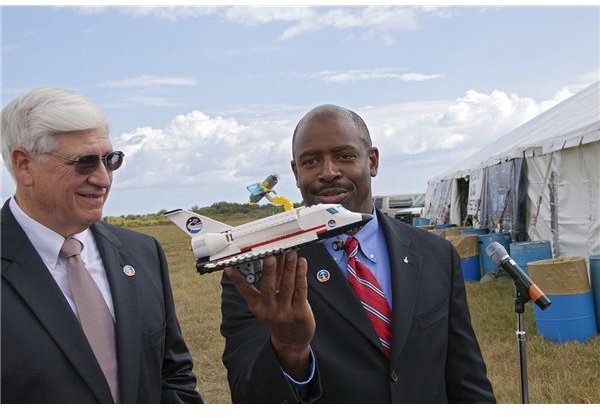THe LEGO NASA Shuttle: The STEM Program Lifts Off Kids Learning About Space
LEGOs and NASA, a Natural Synergy
What could be more natural fit than NASA, LEGOs and kids? Just take a look at the International Space Station – LEGO-like construction at its grandest! And what child can’t resist the temptation to start creating when presented with a colorful pile of LEGO bricks?
With the launch of two LEGO NASA shuttles onboard the Space Shuttle Discovery for STS-133, NASA and the LEGO Group, which is headquartered in Denmark, kick-off a three year partnership to introduce children to the world of science and engineering. More specifically, the purpose of the union of these two renowned organizations is to encourage children to learn about science, technology, engineering and math, otherwise known as STEM.
“Partnering with The LEGO Group is a perfect fit. We have taken the excitement of NASA’s missions and coupled that with kids’ love of creating things with the iconic LEGO bricks,” said Leland Melvin, NASA’s associate administrator for Education. “These projects not only foster creativity but also instill in the young builders a real sense of the engineering and design principles that NASA uses every day. Fun learning activities like these can help inspire kids to become the next generation of explorers.”
_
Space Shuttle Endeavour, on the last slated shuttle mission, STS-134, will carry into orbit a larger version of the space shuttle kit and two kits which will make up the International Space Station. The program has over a dozen planned projects scheduled for the next two years and new kits that are released will include NASA related educational materials.
STEM
LEGOs are one of the most entertaining and instructive toys that can be found in the toy box. The kits guide the builder (young and old alike) through the assembly of many fanciful creations, but the real magic comes with the original kits are broken into their component parts. Faced with a pile of multi-colored, multi-shaped blocks, and armed with one’s imagination, the possibilities are…shall we say, astronomical. When you combine all of this with the programming capabilities of the LEGO robotics kits, it gets even more exciting.
LEGO and NASA are trying to tap the natural curiosity and inventiveness of children by using the LEGO products with structured programs that will help them learn to reason systematically while providing opportunities to learn about science and technology in a hands-on environment. In combination with astronauts on board the International Space Station conducting classes in space, teachers and students on the ground will participate in the learning sessions. The children will get valuable first-hand experience with building demonstrations and demonstrations with the assembled kits. One of the first lessons that will be taught is how to cope with the challenges of building LEGOs in a microgravity environment. The astronauts will use a work bench to help contain and control the bricks as the assemblies are being constructed.
Scientists, Engineers and Astronauts of Tomorrow
Science and math form the essential foundation for the engineering needed to develop the technologies we use every day, from making a slice of toast to landing a rover on Mars. Introducing children to science, technology, engineering and math as early as possible will help them to be comfortable with, and not intimidated by these fields of study. This is critical, as we need to have people trained in the sciences, math and technology to continue the research and development required to push forward the frontiers of space exploration, and tackle the many other challenges we face today. All of this will start with one little LEGO NASA Space Shuttle.
For further information on the NASA/LEGO program and the STEM program see the links in the Reference section below.
References
LEGO-NASA Shuttle STEM:
-
https://www.nasa.gov/mission_pages/shuttle/behindscenes/lego.html
-
https://www.nasa.gov/home/hqnews/2010/nov/HQ_10-285_NASA_LEGO_Team.html
NASA Education: https://www.nasa.gov/offices/education/about/index.html
LEGO Space: https://www.legospace.com/en-us/Default.aspx
